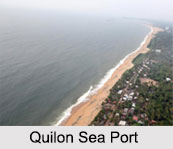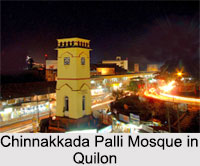 Known to be the oldest port city in the Malabar Coast, Quilon was once the capital of the historic kingdoms of Venad and Travancore. Quilon used to be one of the most important trading ports in India. The wharf of the port is about 177 metres in length and about 12 metres in width, whereby vessels up to 15,000 DWT can berth easily. The primary hinterland of the port extends to Pathanamthitta and the southern parts of the Kottayam and Idukki districts to the central and southern parts of Alappuzha district, Kollam district and Thiruvanathapuram district with the Kanyakumari-Tirnuveli-Madurai and Teni districts of Tamil Nadu. Fed by the Chinese trade, Quilon sea port was regarded by Ibn Batuta, as one of the five ports, which he had seen in the course of his travels during a period of 24 years, in the 14th century AD.
Known to be the oldest port city in the Malabar Coast, Quilon was once the capital of the historic kingdoms of Venad and Travancore. Quilon used to be one of the most important trading ports in India. The wharf of the port is about 177 metres in length and about 12 metres in width, whereby vessels up to 15,000 DWT can berth easily. The primary hinterland of the port extends to Pathanamthitta and the southern parts of the Kottayam and Idukki districts to the central and southern parts of Alappuzha district, Kollam district and Thiruvanathapuram district with the Kanyakumari-Tirnuveli-Madurai and Teni districts of Tamil Nadu. Fed by the Chinese trade, Quilon sea port was regarded by Ibn Batuta, as one of the five ports, which he had seen in the course of his travels during a period of 24 years, in the 14th century AD.
History of Quilon Sea Port
During the 13th century, Quilon was considered to be one of the 4 early entrepots in the global sea trade, along with Alexandria and Cairo in Egypt, the Chinese city of Quanzhou, and Malacca in the Malaysian archipelago. The name Quilon was given to Kollam by the Portuguese. The port city used to be a part of the Chera Dynasty until Mar Abo came along in 825 AD and founded the port during the rule of Udayamarthandavarma the Tamil king of the Venad. The port became the capital city of the Venad kingdom and was used as an alternative to re-opening the inland seaport of Korekeni Kollam near Backare, which is modern day Thevalakkara also known as Nelcynda and Tyndis to the Romans and the Greeks, and Thondi to the Tamils.
It is an ancient trading town and it is said that the Chinese traders were in contact with Quilon and it was a chief port between China and western India. Early travellers had described the port as one of the largest in the world and the market as one of the finest in India. Quilon was so important and prosperous that the origin of the Kollam era in 825 AD was associated with the name of Quilon. In the 4th century, migration of east Syriac Christians to Kerala commenced and by their second migration in 823 AD, they moved in to the city of Quilon. The tradition claims that the Christian immigrants rebuilt the city of Quilon in AD 825 from which date the Malayalam era is reckoned.
 Trade in Quilon Sea Port
Trade in Quilon Sea Port
Quilon is a trade centre and with commodities currently handled or planned on the port include marble, tiles, sand, titanium, seafood, clay, timber, logs, newsprint and waste paper, cement, urea and muriate of potash for fertilizer, rubber, food, agricultural products and cement as well as other commodities and products for local companies in Trivandrum, Kerala.
The two other most important products for which Quilon is known for is cashew and coir. Both form the major source of employment for the people in the rural parts. Quilon is the hub of India`s cashew trading industry. For the women in the rural areas, they manually peel and sort cashews into different categories by size, which is a means for livelihood for them. For the people living by the side of the backwater, coir making is the primary occupation. Travelling using the backwaters will give one the pleasing visuals of villages engaged in the manufacturing of coir. The women along-with their weaving wheels work intimately to fabricate one of the strongest cords in the world. Coconut fibre extracted from coconut husks is used in the making of coir. In the hands of master craftsmen this raw and rough coir is given magical textures and are turned into a number of products like mats and beds.
Nearby Attraction in Quilon Sea Port
Quilon Sea Port includes an age old light house which is 144ft high. Built in 1902 this is one of the biggest attractions of Quilon. Besides this the area also has an attractive temple of Ananda Valleeswaram which attracts a number of devotees from all over Kerala. The area is also surrounded by a number of mosques and churches that represent different architectural superiority. The area includes one of the oldest mosques in Quilon known as Chinnakkada Palli which represents the culture of the area. Along with this the area is also known for the sea beach which again attract the tourists.
Visiting Information on Quilon Sea Port
The nearest airport to the Quilon sea port is Thiruvananthapuram International Airport. Kollam is well connected to other major cities of the country via regular trains.



















